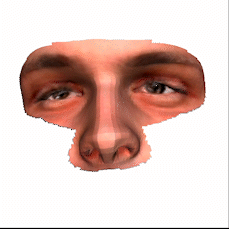Towards Effective Adversarial Textured 3D Meshes on Physical Face Recognition (CVPR 2023, Highlight )
Xiao Yang, Chang Liu, Longlong Xu, Yikai Wang, Yinpeng Dong, Ning Chen, Hang Su, and Jun Zhu.
Demonstration of physical black-box attacks for unlocking one prevailing mobile phone.
Demonstration of digital black-box attacks.
Demonstration of the output 3D patch.
Clone the repository using the following command:
git clone --recursive https://github.com/thu-ml/AT3D.gitBefore using this code for the attack, you need to set up the environment for data preprocessing. In the directory preprocess/get_bfm_mat/Deep3DFaceRecon_pytorch, you must prepare some prerequisite models:
-
Based on the previous work by Deng et al., we use Basel Face Model 2009 (BFM09) to represent 3d faces. Get access to BFM09 using this link and download "01_MorphableModel.mat". In addition, we use an Expression Basis provided by Guo et al.. Download the Expression Basis (Exp_Pca.bin) using this link (google drive). Organize all files into the following structure:
AT3D ├── preprocess │ └── get_bfm_mat │ └── Deep3DFaceRecon_pytorch │ └─── BFM │ └─── 01_MorphableModel.mat │ └─── Exp_Pca.bin | └─── ... -
Download the pre-trained model using this link (google drive) and organize the directory into the following structure:
AT3D ├── preprocess │ └── get_bfm_mat │ └── Deep3DFaceRecon_pytorch │ └─── checkpoints │ └─── face_recon │ └─── epoch_20.pth -
Download the topology matrix of different shapes using this link (google drive) and organize the directory into the following structure:
AT3D ├── data ├── BFM_model_front_patch.mat └── demo ├── origin └── results
To install the specific python environment, run conda env create -f environment.yml.
To prepare the input data for the attack, you should first run run_preprocess.sh.
bash ./run_preprocess.shIf the shell script is successfully executed, you will have following outputs, which will be the required inputs for the attack.
- The coordinates of five landmarks detected for the original picture, e.g.
/data/demo/origin/444/detection_444.txt - The BFM reconstruction coefficients for every identity in pictures under
/data/demo/origin, e.g./data/demo/origin/444/444.mat - 224x224 picture output by the reconstruction model. e.g.
/data/demo/origin/444/final_444.png - The align matrices for the 224x224 picture output by reconstruction model, e.g.
/data/demo/origin/444/align_final_444.npz(if you apply the matrices to the picture, it will scale to 112x112 (or 112x96).) - The embeddings/features output by different face recognition models (now we only save the results of
ArcFace,CosFaceandResNet), e.g./data/demo/origin/444/embedding_final_444.npz
To implement an attack, you should add attack pairs in configuration files, e.g. pairs_patch.txt. Configuration files for different attack methods may have different formats.
[the path of the attacker's 224x224 picture output by reconstruction model] [the path of the victim's 224x224 picture output by reconstruction model] [the path of the align matrix of the attacker] [the path of the 3dmm coefficients of the attacker] [the path of the 3dmm coefficients of the victim] [the path of npz file which contains the embeddings (output by different face recognition models) of the victim]
To see how to write a configuration file for an attack, you can refer to /data/demo/pairs_patch.txt.
# run 2D attack using MIM method
bash ./run_attacks_2D_MIM.sh
# run 2D attack using MIM method with EOT
bash ./run_attacks_2D_EOT.sh
# run 3D attack with perturbation directly on mesh
bash ./run_attacks_AT3DM.sh
# run 3D attack with perturbation directly on mesh, considering smoothing loss
bash ./run_attacks_AT3DML.sh
# run 3D attack with perturbation on 3DMM coefficients
bash ./run_attacks_AT3DP.shYou can see the attack results under /data/demo/results. The directory of attack results will be:
/data/demo/results/[attack method]/[patch shape]/[attacker's name]/[victim's name]/
Under the directory, you will find two pictures generated during the attack process. One is the adversarial example shown in a two-dimension way, the other is a concatenated picture of the attacker, victim and the adversarial example. If you don't want the concatenated picture, just modify the corresponding bash script and set the --visualize argument to be False.
In addition, you can see the result obj file if you perform a 3D attack. You can open it with a 3D viewer, such as MeshLab.
If you find our work useful to your research, please consider citing:
@article{yang2023towards,
title={Towards Effective Adversarial Textured 3D Meshes on Physical Face Recognition},
author={Yang, Xiao and Liu, Chang and Xu, Longlong and Wang, Yikai and Dong, Yinpeng and Chen, Ning and Su, Hang and Zhu, Jun},
journal={arXiv preprint arXiv:2303.15818},
year={2023}
}
The face images in /data/demo/origin are from the public CelebA-HQ dataset released by MMLab, CUHK.
Here are some great resources we benefit:
- Deep3DFaceRecon_pytorch for representing 3d faces
- Nvdiffrast – Modular Primitives for High-Performance Differentiable Rendering for differentiable rendering
- Face Robustness Benchmark (RobFR) for basic adversarial attack implementation


